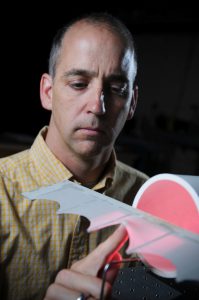by Whitney Taylor and Mary Wymer

Facts, stories and legends of flight fill the pages of history. From the ancient Greek myths of Icarus to the Wright brothers’ first airplane flight in 1903, the world has seemingly always been enraptured with the possibilities of flight and soaring through the open skies.
These days, the skies tend to be filled with everything from a double-decker Airbus carrying more than 500 passengers to the C-5 Galaxy, a cargo transport nearly the length of a football field. While colossal aircrafts may be dominating the skies, something bigger is dominating the field of aerial vehicle research – something which could monitor traffic, locate enemy troops and even detect chemical weapons. These aerial contraptions with “larger-than-life” possibilities are micro air vehicles, ranging from insect-size up to six inches.
Micro air vehicles, known as MAVs, are miniature, unmanned, aerial robots primarily used for military reconnaissance and surveillance purposes. The vehicles usually are equipped with a camera, battery, sensors and other necessary equipment. As an understudied area new to the aeronautical world, researchers are exploring the use of these aircrafts for defense and security operations.
When not lecturing aerospace engineering students about the finer points of aerodynamics, you can find Dr. Paul Hubner, assistant professor of aerospace engineering and mechanics at The University of Alabama, lost in the depths of the wind tunnel lab in Hardaway Hall with his team of students. Hubner is studying an aspect of MAV that enables flight–the wing.
There are three basic types of MAV wings: a stationary wing, a flapping wing and a spinning, rotary wing. Hubner focuses on the lift, drag and aerodynamic efficiency of the flexible, stationary wings. Additionally, he measures the flow field fluctuations and membrane vibrations to better understand the aerodynamic basics for improving and building a better wing.
In the wind tunnel lab, the team works on a model fixed wing. Although rectangular in shape, it has a span similar to a typical song bird. Hubner is specifically studying an added membrane to the wing. The membrane, made from latex or nitrile, is a thin sheet of rubber less than a millimeter in thickness, and its flexibility affects flight efficiency and control. While the addition of a membrane can be advantageous, Hubner is reviewing the wing’s tolerance to damage.
Hubner also researches conventional wing shapes and the use of scalloping, which is the process of cutting away material along the trailing edge of the wing. Scalloping can improve the MAV’s flight efficiency by reducing drag while minimally affecting lift.
The genesis of researching the effects of scalloping and the addition of membranes is “bio-inspired,” similar to natural elements and organisms of the environment. These bio-inspired components include designing the wing shape like those prevalent in nature, such as bat wings or whale fins.
“MAVs are on the same scale as many small flying animals, so it would be reasonable to study and employ some of the wing and flight characteristics of birds, insects and mammals,” says Hubner.
“I have been surprised by how many angles we are approaching in our study of MAVs in order to better understand them,” says Travis Hicks, a graduate student in aerospace engineering. “We have studied MAVs using wake measurements and smoke visualization, and I anticipate adding more advanced techniques in our studies.”
Researchers around the world are furthering the exploration and research of these miniature aircrafts. And, as Hubner continues the studies and paves the way at the Capstone, he is making The University of Alabama an integral part in the research of cutting-edge technology that could forever change the history of defense and security operations around the world.